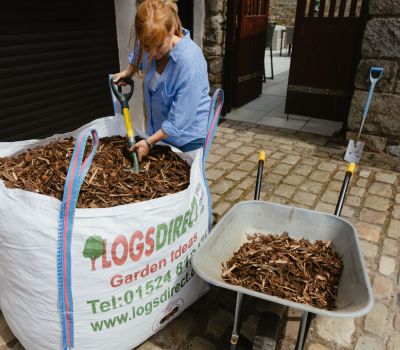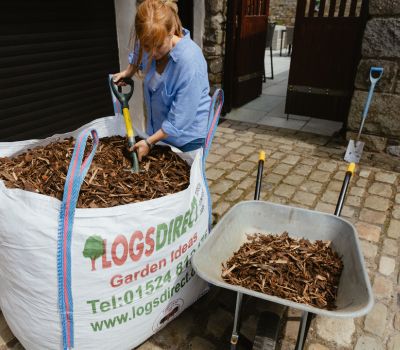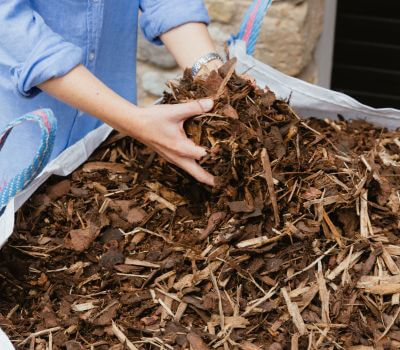Bark Mulch - What is it and how to use it in your garden.

How to Use Bark Mulch to Retain Soil Moisture and Nutrients During Hot Weather

During periods of hot, dry weather, gardeners often face the challenge of keeping plants hydrated and soil healthy. One of the most effective and natural solutions is bark mulch. This organic material not only helps conserve water but also improves soil structure and supports long-term plant health.
In this guide, we’ll explore how to use bark mulch effectively in your garden, its key benefits during summer, and how to get the most from it with simple best practices.
What Is Bark Mulch?
Bark mulch is made from the outer bark of trees, typically from softwoods such as pine, spruce or larch. It comes in different grades, ranging from fine to coarse chips, and is commonly used to cover soil around plants, trees, shrubs, flower beds and pathways.
As well as offering a neat and natural finish to your garden, bark mulch provides numerous practical benefits—particularly when temperatures rise and rainfall is limited.
Why Use Bark Mulch in Hot Weather?
- Helps Retain Soil Moisture - One of the biggest threats during hot spells is moisture loss from the soil. Bare soil quickly dries out under direct sunlight, meaning more frequent watering is needed. Applying a layer of bark mulch helps trap moisture in the soil, reducing evaporation and keeping roots hydrated for longer.
- Enriches the Soil Over Time - As bark mulch slowly decomposes, it adds organic matter to the soil. This improves its structure, increases nutrient levels and supports the growth of beneficial microorganisms, creating a healthier growing environment.
- Regulates Soil Temperature - Mulching with bark helps to moderate temperature swings by insulating the soil. In hot weather, it keeps soil cooler, helping to protect delicate roots and reduce plant stress. It also helps retain warmth in cooler evenings, offering consistent growing conditions.
- Reduces Soil Erosion and Compaction - Heavy watering, wind and foot traffic can lead to erosion or compacted soil. Bark mulch forms a protective layer that reduces surface run-off, minimises disruption and keeps your soil in better condition throughout the season.
How to Apply Bark Mulch in the Garden
- Choose the Right Type - There are several types of bark mulch available:
- Fine mulch: Suitable for vegetable patches and flower beds
- Medium mulch: Ideal for borders and shrubs
- Large bark chips: Perfect for decorative paths, tree bases and long-term coverage
Ensure you use mulch that is well-composted or aged, as freshly chipped wood can temporarily draw nitrogen from the soil.
- Prepare the Area - Before mulching, it's important to:
- Remove existing weeds: Mulch helps suppress new growth but won't kill what's already there. Use a mid handled weeding fork to make life easier and ensure you get the whole root and stop the weeds returning.
- Water the soil thoroughly: Mulch locks in moisture, so it should be applied to already damp ground
- Apply an Even Layer - Spread bark mulch evenly across the surface, aiming for a depth of 5 to 7 cm (2 to 3 inches). Take care not to pile mulch directly against plant stems or tree trunks, as this can encourage rot or pest problems.
- Maintain and Top Up - Over time, bark mulch will decompose and become compacted. Check it regularly and top it up as needed to maintain full coverage and effectiveness.
Best Areas to Use Bark Mulch
- Around trees and shrubs
- In perennial flower beds and borders
- On garden pathways and foot traffic zones
- Under hedges and ornamental planting
- In raised beds or vegetable gardens (using fine mulch)
Common Mistakes to Avoid
- Applying mulch too thinly – Less than 5 cm won’t offer sufficient protection
- Skipping the watering step – Soil should be moist before mulch is laid
- Mulching over existing weeds – Always clear them first
- Piling mulch too close to plants – Leave space around stems to prevent disease

Sustainable and Low Maintenance
Bark mulch is a natural by-product, often sourced from the timber industry, making it a sustainable and environmentally responsible option. It reduces the need for chemical weed control, conserves water, and improves soil organically, all with minimal effort required.
Final Thoughts
If you're looking to protect your garden during summer heat, bark mulch is one of the most effective tools at your disposal. It helps retain moisture, enriches soil, regulates temperature, and keeps weeds at bay — all while giving your garden a smart, well-kept appearance.
By applying bark mulch now, you’ll save time on watering and enjoy a healthier, more resilient garden all summer long.
Where to Buy Bark Mulch
Looking for high-quality bark mulch for your garden? Explore a range of options here
Frequently Asked Questions
Q. How often should bark mulch be replaced?
A. Typically, once per year. However, you may need to top it up more frequently if you notice it thinning or decomposing more quickly.
Q. Is bark mulch suitable for vegetable gardens?
A. Yes, especially fine bark mulch. Just make sure it’s well-composted to avoid nutrient lock-up.
Q. Does bark mulch attract pests?
A. Properly aged bark mulch does not typically attract pests. Avoid piling it too high against plants or trees to prevent hiding spots for insects.
Q. Can bark mulch affect soil pH?
A. Over time, bark mulch may slightly acidify the soil. This is usually minimal and beneficial for most plants, but if you’re growing species that prefer alkaline soil, monitor pH accordingly.
Q. What tools will I need to spread bark mulch?
A. As with all jobs in the garden, the right tool will make the job easier and quicker. The recommended tools would be:
- A wheelbarrow - to help transport the mulch from bag to the area to be covered.
- A quality weeding fork - to remove any weeds before adding barkmulch
- A sturdy garden fork - to aerate the soil before adding any mulch
- A garden rake - helps spread the bark mulch once tipped onto the ground


